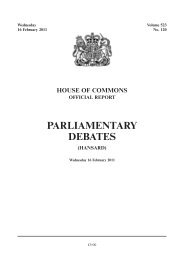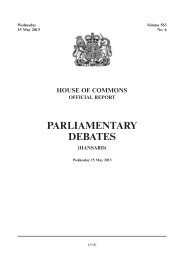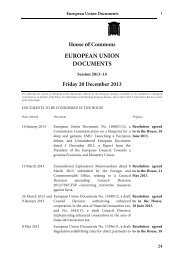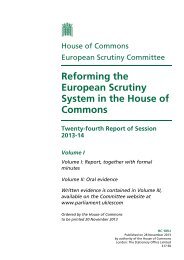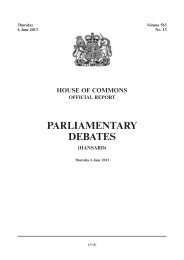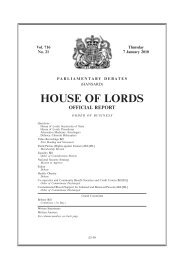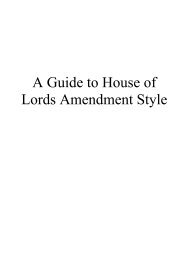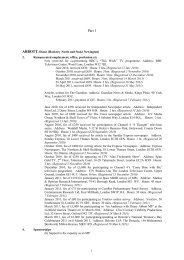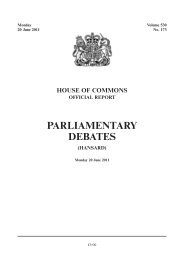Ticketing and Concessionary Travel on Public Transport - United ...
Ticketing and Concessionary Travel on Public Transport - United ...
Ticketing and Concessionary Travel on Public Transport - United ...
You also want an ePaper? Increase the reach of your titles
YUMPU automatically turns print PDFs into web optimized ePapers that Google loves.
7. The Government’s strategy of using ITSO as a way to promote integrated ticketing is<br />
a step in the right directi<strong>on</strong>, but not enough. It is fine in theory but not producing<br />
results in practice. ITSO may be a useful technical specificati<strong>on</strong> but it is designed to<br />
facilitate integrated ticketing, rather than to make it happen. The Government needs<br />
also to articulate a clearer strategy for the development of integrated ticketing in<br />
general <str<strong>on</strong>g>and</str<strong>on</strong>g> smartcards in particular. The current laissez-faire approach is<br />
inadequate. The Government must listen carefully to the transport operators <str<strong>on</strong>g>and</str<strong>on</strong>g> the<br />
technology industry. The criticisms of ITSO need to be addressed <str<strong>on</strong>g>and</str<strong>on</strong>g> the<br />
Government must ensure it has adequate technical capacity to provide leadership in<br />
this area. (Paragraph 50)<br />
Revenue protecti<strong>on</strong> <str<strong>on</strong>g>and</str<strong>on</strong>g> the powers of ticket inspectors<br />
8. Revenue protecti<strong>on</strong> does not get the attenti<strong>on</strong> that it warrants: a bigger <str<strong>on</strong>g>and</str<strong>on</strong>g> more<br />
sophisticated effort is needed. The extent of the problem is poorly understood. It<br />
ranges from passengers willing but unable to pay their fares through to deliberate<br />
fare evasi<strong>on</strong>. Fare-dodging is often associated with other antisocial behaviour <str<strong>on</strong>g>and</str<strong>on</strong>g><br />
efforts to curb <strong>on</strong>e are likely to impact positively <strong>on</strong> the other. More regular <str<strong>on</strong>g>and</str<strong>on</strong>g><br />
coordinated research <str<strong>on</strong>g>and</str<strong>on</strong>g> m<strong>on</strong>itoring of the problem are required. Leaving it to<br />
individual companies who are likely to be averse to sharing or publishing<br />
informati<strong>on</strong> means that no <strong>on</strong>e has a clear picture <str<strong>on</strong>g>and</str<strong>on</strong>g> revenue protecti<strong>on</strong> measures<br />
are likely to be inadequate. (Paragraph 55)<br />
9. There are moves to install ticket gates at more rail stati<strong>on</strong>s. Yet ticket gates are not a<br />
panacea. They cannot be used by all passengers <str<strong>on</strong>g>and</str<strong>on</strong>g> staff are still required to be<br />
present. Gates introduce new drawbacks including delays <str<strong>on</strong>g>and</str<strong>on</strong>g> obstructi<strong>on</strong>s for<br />
passengers; they are not in keeping with historic stati<strong>on</strong>s; <str<strong>on</strong>g>and</str<strong>on</strong>g> they are not always the<br />
best method of protecting rail revenue. The Government, in c<strong>on</strong>sultati<strong>on</strong> with the<br />
rail industry <str<strong>on</strong>g>and</str<strong>on</strong>g> passenger groups, needs to review this <strong>on</strong>e-track approach <str<strong>on</strong>g>and</str<strong>on</strong>g><br />
develop a more holistic policy. (Paragraph 60)<br />
10. An integrated ticketing system should be backed by an integrated revenue protecti<strong>on</strong><br />
system. Whilst the current regulati<strong>on</strong>s for rail are generally satisfactory, those for<br />
buses are not. The powers of bus revenue protecti<strong>on</strong> staff should be strengthened. In<br />
the l<strong>on</strong>ger term, the Government should move towards a unified system of public<br />
transport revenue protecti<strong>on</strong>. The implicati<strong>on</strong>s of new ticket types <str<strong>on</strong>g>and</str<strong>on</strong>g> technologies<br />
will also need to be c<strong>on</strong>sidered. (Paragraph 66)<br />
11. The current appeals procedures for bus <str<strong>on</strong>g>and</str<strong>on</strong>g> rail are not sufficiently independent. The<br />
c<strong>on</strong>sequences of being accused of fare dodging can be serious <str<strong>on</strong>g>and</str<strong>on</strong>g> it is important that<br />
the procedures are just <str<strong>on</strong>g>and</str<strong>on</strong>g> rigorous. The current principal rail appeal panel is<br />
associated with the rail industry <str<strong>on</strong>g>and</str<strong>on</strong>g> this undermines its credibility as a truly<br />
independent arbiter, sitting equidistant from the passenger <str<strong>on</strong>g>and</str<strong>on</strong>g> the train operating<br />
company. The bus industry appeals body has no regulatory backing. The<br />
Government should c<strong>on</strong>sult <strong>on</strong> new arrangements. For rail this might involve giving<br />
resp<strong>on</strong>sibilities to the Office of Rail Regulati<strong>on</strong> or Passenger Focus; for bus it might<br />
be the Traffic Commissi<strong>on</strong>er or the proposed Passenger <strong>Transport</strong> User Committee.<br />
(Paragraph 71)<br />
31



